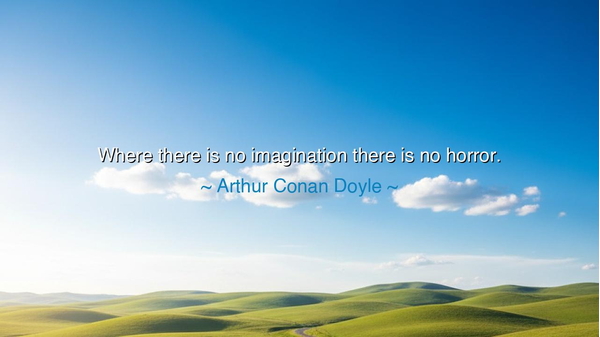
Where there is no imagination there is no horror.






The Shadow and the Flame: On Imagination and the Birth of Horror
Hear, O listener of ages, the words of Arthur Conan Doyle, the master of mystery and maker of legends: “Where there is no imagination there is no horror.” In this brief utterance, he reveals a truth as sharp as the edge of fear itself — that horror, that trembling awe which chills the heart and awakens the soul, is not born from the world alone, but from within us. For it is imagination that gives life to terror, just as it gives life to beauty. Without imagination, the dark is only darkness; but with imagination, it becomes a realm of whispers, of unseen beings, of the vast and dreadful unknown.
Doyle, whose mind gave birth to both the logical brilliance of Sherlock Holmes and the eerie mysteries of the supernatural, understood the delicate balance between reason and imagination. He knew that the same power which allows us to see beauty in a sunrise also allows us to see ghosts in the shadows. Imagination is the breath of wonder — it magnifies life, exalts it, and sometimes distorts it into terror. Thus, he teaches that horror is not merely in the external world but in the creative mind that shapes meaning from silence, menace from mystery. To imagine deeply is to be vulnerable — for the same mind that dreams of angels can also conceive of monsters.
The ancients knew this truth long before Doyle gave it words. When early humanity first gazed into the night sky, they saw not stars alone, but gods and demons moving among them. The rustling of leaves in the forest was not merely wind — it was the footstep of a spirit. To those without imagination, the world was quiet and dull; but to those who dreamed, it was alive, filled with danger and wonder alike. Imagination gave form to fear, but also to faith. Without it, there would have been no gods, no stories, no art — and no horror. For it is only by imagining what lies beyond understanding that the human soul begins to tremble in awe of the infinite.
Consider the story of Mary Shelley, who, in the dark of a stormy night, imagined the spark of life flickering within a lifeless body. Out of her imagination was born Frankenstein, the first modern tale of science’s monstrous shadow. The horror of her creation did not lie merely in the creature itself, but in the realization it awakened — that human ambition, untempered by compassion, could give birth to tragedy. Her imagination reached beyond her age and saw the cost of progress without conscience. Thus, in horror, she revealed truth; in terror, she found wisdom. This is what Doyle meant: horror arises not from evil itself, but from our imaginative awareness of what evil means.
Yet, Doyle’s insight carries more than a writer’s reflection — it holds a philosopher’s warning. If imagination gives rise to horror, it is because imagination gives depth to all experience. The man without imagination lives numb to both terror and joy. He walks through the world untouched, neither haunted nor inspired. But the man of imagination feels deeply — he suffers, yes, for he perceives the hidden wounds of life — but he also creates. For it is through imagining horror that we learn to imagine its opposite — hope. Those who can picture the depths of despair are also those who can envision the heights of redemption.
Indeed, horror and imagination are twin mirrors of the same mystery: the awareness that existence holds more than what can be seen. Horror reminds us of our fragility, of the limits of human control, of the abyss that lies beneath the surface of comfort. And yet, it is in confronting that abyss — through story, art, and reflection — that we grow stronger. The courageous do not silence their imagination; they confront it, shaping its terrors into understanding. Just as the sculptor wrestles with marble to release beauty, the soul must wrestle with its fears to reveal wisdom.
So, O reader of the living and the dead, take this teaching into your heart: do not flee from your imagination, even when it frightens you. Let it show you the shadows that dwell within, for only by seeing them can you bring them into light. Imagination is not the enemy of reason, but its awakening; horror is not the end of hope, but the proof that hope still matters. The next time you feel fear arise from an unseen place, remember Doyle’s words — that your terror is the sign of life within you, the mark of a mind that can still wonder, still feel, still create.
Thus, as Arthur Conan Doyle teaches, where there is no imagination, there is no horror — but neither is there glory, courage, or love. The same power that paints demons in the dark can also paint dawn upon the horizon. To imagine is to be human; to fear is to feel; to create from both is to transcend. For in the deepest caverns of imagination, horror and hope are born together — and from their struggle rises the eternal spirit of man.






AAdministratorAdministrator
Welcome, honored guests. Please leave a comment, we will respond soon